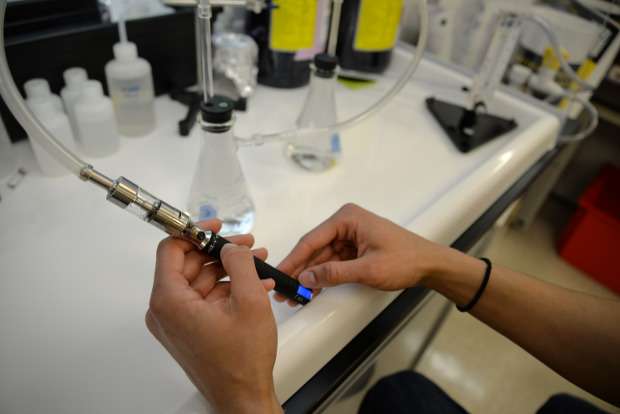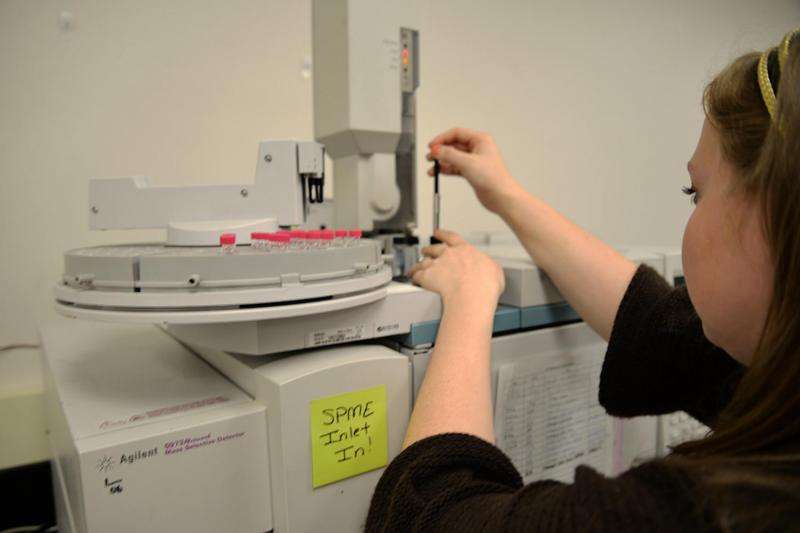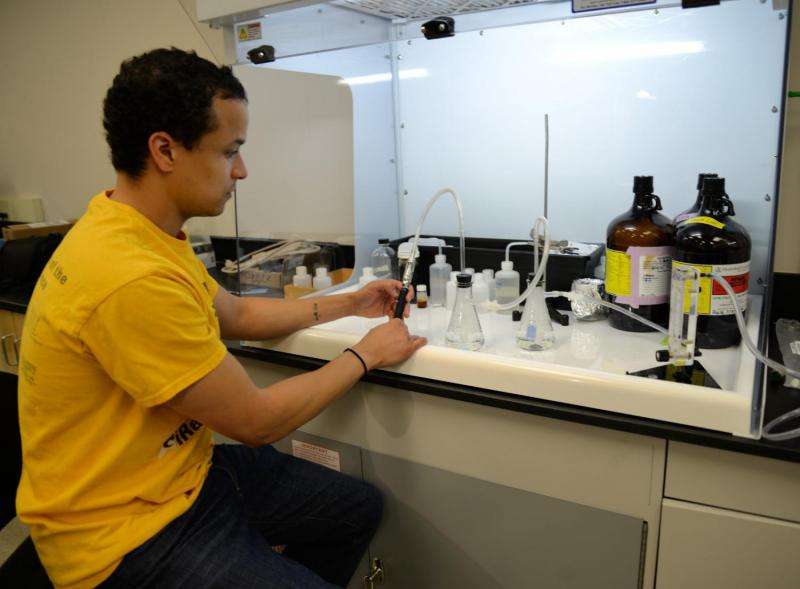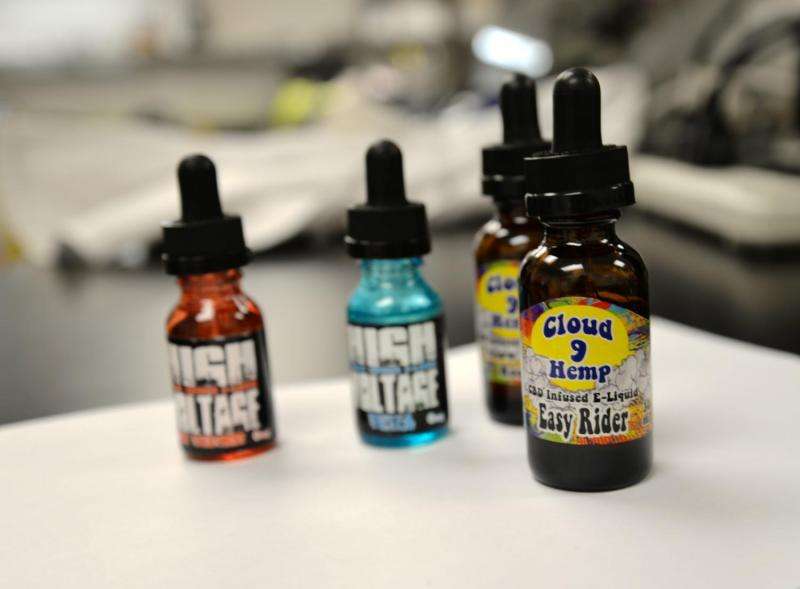Researchers study the use of e-cigarettes for illicit drugs

In a Department of Forensic Science lab at Virginia Commonwealth University, a contraption mechanically puffs on an e-cigarette loaded with methamphetamine, testing how much of the illegal drug is contained in the vapor cloud.
"We are still in the process of looking at meth, so we're not ready to draw any definite conclusions other than, yes, it's in the vapor, and, yes, it's present in 'reasonable' concentrations—or unreasonable, depending on your viewpoint—meaning that it's vaporizing easily and it's easy to detect," said Michelle Peace, Ph.D., assistant professor and associate chair of forensic science in the College of Humanities and Sciences. "We haven't tested THC [the primary psychoactive component of marijuana] or heroin yet, but we should be running those later in the summer."
An interdisciplinary team of VCU researchers led by Peace received a roughly $339,000 grant from the National Institute of Justice in the U.S. Department of Justice to launch one of the first studies exploring how drug users are increasingly using e-cigarette devices to vape illicit drugs. Her team includes faculty and researchers from both VCU campuses and from the Departments of Forensic Science, Chemistry, Pathology, and Pharmacology and Toxicology, and undergraduate and graduate students from the Department of Forensic Science.
The grant, "Characterization and Abuse of Electronic Cigarettes: The Efficacy of 'Personal Vaporizers' as an Illicit Drug Delivery System," set out to test e-cigarettes' viability as a method to vape marijuana, heroin, methamphetamine and other drugs—a trend that has been heralded widely in recent years by drug users in online forums, blogs and videos.
"We found that on all the drug forums and blogs and YouTube videos … users were advocating, 'Oh, wow. You can vape methamphetamine at work, and nobody would ever know because you can't smell it,' Peace said. "Or, 'You can vape THC, and it doesn't have the characteristic odor of lighting up a joint.' We were seeing things like, 'You can carry your e-cigarette filled with THC onto a plane, and nobody is going to question you.' Or, 'You can easily transport illegal drugs. Just put it in your e-cig.'"
In 2013, Saturday Night Live ran a commercial parody for "e-meth," an e-cigarette for vaping meth. And in 2014, Sarah Silverman famously showed off her e-cigarette filled with marijuana on the Emmys red carpet.
"Go on to YouTube or Vine, and you'll find hundreds of kids and young adults that are vaping [illegal drugs]," Peace said. "All you've got to do is search for the hashtags #THCvape, #marijuanavape, #mjVape, #methvape. So it's not just being talked about it in the media or done by celebrities; kids are doing this."
With the popularity of e-cigarettes apparently growing among illegal drug users, the researchers wanted to find out the facts behind the trend.
"With this grant, we're asking: Are electronic cigarettes really an effective, efficient way to vape illicit substances. Does it work?" Peace said.
Designing a testing model for e-cigarettes
The team's first objective was to design a system that could measure the output of the illicit drugs from an e-cigarette device.

"We knew that we needed to mechanically vape the e-cigarette," Peace said. "We're not going to have a student vape, obviously. So we had to build a vaping machine."
Tyson Baird, a forensic scientist in the toxicology laboratory for the Sedgwick County Regional Forensic Science Center in Wichita, Kansas, and a 2015 graduate of VCU's Master of Science in Forensic Science Program, helped design the e-cigarette analysis model.
"When we began the project, we had a lot of ideas about where we wanted to go, but we had to figure out some of the basics," he said. "That involved figuring out a little about how they worked, determining the overall composition of the e-cigarette liquid formulations, and devising a method to trap and analyze the 'smoke' or 'vapor' that comes out of them."
Karen Butler, who received her master's degree in forensic science from VCU in May, helped develop the testing model, which involves two water traps attached to a vacuum.
"Our lab group has created a simple trapping system that can be made using standard laboratory glassware and a vacuum line," she said. "We simply connect the e-cigarette to the system, which has a vacuum pull to emulate someone 'vaping' the e-cigarette, then power-on [the] e-cigarette."
The researchers tested out the system using nicotine e-liquid, before moving on to substances like methamphetamine, as well as legal pharmaceuticals such as vitamins and caffeine.
"My portion of the project involved determining a way of directly characterizing the aerosol produced by the e-cigarette," Butler said. "In order to capture the aerosol, I use a technique called solid-phase microextraction, or SPME. These fibers have a coated surface that allows them to capture components of the aerosol that are within a specific molecular weight range."
The team then analyzes the fibers with a Direct Analysis in Real-Time Accu-TOFTM Mass Spectrometry, or DART-MS, instrument and a gas chromatography-mass spectrometry system. "Combined, the use of these two instruments provide us with both a screening and confirmatory method for the analysis of aerosol in e-cigarettes," she said.
Justin Poklis, manager of the Mass Spectrometry Laboratory in the Department of Pharmacology and Toxicology in the School of Medicine, also helped the team develop methods for the analysis of e-liquids used in e-cigarettes.
Poklis said he believes the project will "bring awareness to the forensic science community of e-cigarettes as an effective drug delivery system and [will] provide information about e-liquids used in e-cigarettes, including the types of drugs and compounds found in them."
He added that the "research has been an exciting collaboration between both the VCU Monroe Park and MCV campuses, involving the Departments of Forensic Science, Pharmacology and Toxicology, Chemistry and Pathology."

Causes for concern
Joey Stone, who recently graduated with a master's degree in forensic chemistry on the drugs and toxicology track, was also part of the research team, focusing on whether or not increasing the voltage on an e-cigarette would translate into an increase dose delivery, especially pertaining to illicit drug use, such as methamphetamine or THC.
"I loved researching this topic because there are so many questions that still need to be answered about e-cigarettes and e-liquids," Stone said. "[There are many] questions regarding the lack of standards in producing these products as well as determining if there are any potentially harmful or beneficial effects that can result from vaping."
Stone's main project was to analyze commercially available e-liquids to see if the purported contents matched the labels. One e-liquid he analyzed was from a Washington-based company called Liberty Reach that claimed to contain 69.1 percent THC.
The findings, "Analysis of a Commercial Marijuana e-Cigarette Formulation," were published in the April edition of the Journal of Analytical Toxicology. Stone was among the article's authors.
"This e-liquid stated to contain 69.1 percent THC and 1.0 percent CBD (another marijuana cannabinoid, however non-psychoactive)," he said. "However, the e-liquid only contained 42.6 percent THC and 0.5 percent CBD, as well as four other unlabeled cannabinoids."
The lack of labeling oversight of e-liquids is a major cause for concern, Peace said.
"We went on a website and found e-liquid advertised as containing kratom, a drug derived from a botanical and currently on the DEA's watch list. We bought six bottles of it—three bottles were labeled as containing kratom and three bottles were not labeled as containing kratom, but they all did," she said. "That's scary."
Peace recently consulted on a case in which a person claimed they had vaped e-liquid unaware that it contained drugs besides nicotine.
"Now they're [testing] positive [for drugs] and run the risk of not being able to do the job they're paid to do. And I told the group I consulted with, 'Yes, it's completely possible that they purchased this [e-liquid] and it was not labeled as containing that drug,'" she said.
Wider implications for forensic science, law enforcement

Jimmy Stewart, who just finished his first year as a forensic science graduate student at VCU in the drugs and toxicology track, will serve as the project's chemical hygiene officer, conducting research into the metal coils that provide the heat to form the e-cigarette vapor that the user inhales.
"The role that the coil plays in the e-cig setup is an important one that has not been investigated thoroughly," he said. "Many e-cig users claim that vaping is safer than smoking regular cigarettes because there is no burning involved and that the toxic substances found in traditional cigarettes are absent in the e-cig vapor. The goal of this research is to do a comprehensive analysis of the standard e-cig coils to determine if the claim of e-cigarettes being 'safer' is valid or not."
Haley Mulder, who just graduated from the undergraduate program in forensic science and will enter VCU's master's program in forensic chemistry with a focus in drugs and toxicology this fall, is working as the lab manager where the e-cigarette research is being conducted.
Mulder was also one of the first undergrads on the project, and launched the "coil burning project" experiment, which is being conducted to determine the maximum temperature output of the coils used to aerosolize the e-liquid in the e-cigs under different configurations and conditions.
"We've recently observed some trends that indicate that the temperature output of the coils could potentially affect the size of the aerosolized particles which would affect the efficiency of how the drug is delivered to the user," Mulder said.
For many of the students, it has been exciting to work on a cutting-edge project with implications for the wider forensic science and law enforcement communities.
"Every day you see news stories discussing these devices and to know that you are researching such a hot topic is very exciting," Mulder said. "And to know that there has been little research on this topic creates a very exciting frontier for discovery, which is the heart of scientific research."
Butler, who will begin pursuing a doctorate in analytical chemistry at North Carolina State University in the fall, agreed.
"Because the vaping culture is such a growing and rapidly evolving community, and the forensic implications of these devices are emerging, it's really important that we truly understand what is happening in these devices so that the forensic science community can understand the types of evidentiary samples that they may be receiving, as well as how to process the different types of evidence," said Butler. "Providing the forensic science community with a basis for analysis is very important, as these devices are becoming more commonly seen in drugs and toxicology cases."
Baird, the forensic scientist in Kansas, said the project is providing important research to the field.
"This research is not only developing the methods to understand issues of illicit vaping, from abuse potential to laboratory analysis, it's also creating the awareness in the forensic science and criminal justice communities that they can be abused," he said. "And now, when instances of illicit substance abuse involving e-cigarettes are identified, techniques already exist for proper forensic analysis in those cases."
More information: Michelle R. Peace et al. Analysis of a Commercial Marijuana e-Cigarette Formulation, Journal of Analytical Toxicology (2016). DOI: 10.1093/jat/bkw021
















